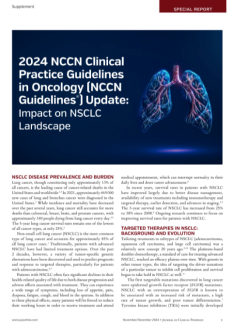How Integrated Health System Pharmacies Enhance Treatment Adherence and Adverse Effect Management for CLL
In this interview, Houston Wyatt, PharmD, CSP; Chelsea Renfro, PharmD; and Stephanie White, PharmD, CSP, from Vanderbilt Health provide an overview of the findings from their study entitled “Integrated health system pharmacy role in adherence, persistence, and adverse effect management for oral chronic lymphocytic leukemia therapy.” They also discuss how clinical pathways and similar strategies can assist with patient outreach and medication adherence for patients with chronic lymphocytic leukemia/small lymphocytic lymphoma (CLL/SLL).
Your study highlights the role of pharmacists in patient education and adverse effect management. What were some of the most frequent patient-reported challenges regarding their treatment, and how did pharmacist interventions help improve their experience?
The most frequent patient-reported challenges were adverse effects, including bruising, rash, diarrhea, headache, and fatigue. Patients were educated on these side effects before beginning treatment and instructed to follow up in the clinic for scheduled appointments and laboratory work. Patients experiencing adverse effects, which were reported to a pharmacist, were provided mitigation strategies such as loperamide for diarrhea, topical steroid use or antihistamine use for rash, and over-the-counter (OTC) analgesic use for headache. Patients were instructed to contact the pharmacist or physician if their adverse effects worsened or were unmanageable.

What specific pharmacist-led interventions were most impactful?
The most impactful interventions were mitigation strategies that resolved the adverse effect, dose reductions if indicated to ensure patients remained on therapy, and follow-up for resolution of adverse effects or therapy change if the adverse effects were not tolerable.
Based on your study’s findings, how might clinical pathways for CLL/SLL be adjusted to better integrate pharmacist-led interventions and improve medication adherence and persistence?
Though our institution does not utilize pathways for CLL/SLL, our pharmacy model has implemented strategies to help impact medication adherence and persistence. Patients are followed closely during treatment, and appropriate education is provided to patients before initiating therapy. Each patient is given a follow-up call/message via electronic health record (EHR) within 30 days of each subsequent medication fill. This phone call/EHR message involves asking certain questions for patients to report any adverse effects, missed doses, quality-of-life issues, health care utilization, or any other concerns the patient may have. Any concerns reported out of the scope of a pharmacist are relayed to the physician through the patient’s EHR.
Patients are also provided with a direct contact within the Vanderbilt Specialty Pharmacy to report any concerns. We have an on-call pharmacist available 24/7 to address any questions outside of our normal operating hours. In certain disease states outside of CLL/SLL, we have implemented tailored monitoring calls, including touchpoints with a patient within a designated time frame before the initial 30-day follow-up call. This allows our specialty pharmacy to be proactive for certain disease states or medications requiring more frequent follow-up. Each patient is also reassessed at least annually, and their EHR is reviewed for any changes in disease state or medication.
Given that adverse effects were a major driver of therapy discontinuation and switching, do you see an opportunity for clinical pathways to incorporate more personalized treatment strategies, such as predictive markers for tolerability, pharmacist-driven risk assessments, and more patient involvement in the treatment selection process before initiating therapy?

Our pharmacy model involves a pre-treatment assessment of a patient's EHR for their past medical history and current medication list to review with the planned treatment regimen. If a medication risk with a comorbid condition or a drug-drug interaction is found, this information is relayed to the provider to make a decision on the best treatment option moving forward. Since our institution does not utilize a pathway, this assessment provides the physician with the information needed if there is a concern for any risk(s) that may be involved in starting a therapy.
As previously mentioned, using a tailored monitoring outreach approach may also be useful within certain drug classes to identify early concerns with adherence or safety. Our specialty team continues to investigate new ways to interact with patients early after initiating oral oncolytic therapy to increase the chance to identify and address potential issues, ideally within the first 7 to 14 days.
Given that pharmacist interventions led to positive outcomes in a significant number of cases, how do you envision this study influencing clinical practice guidelines or the integration of pharmacists into multidisciplinary CLL/SLL treatment teams?

This study confirmed our current specialty pharmacy model provides benefit to patients and providers by ensuring any potential risks are addressed before initiating therapy. Our model also makes certain that patients are provided thorough education at initiation of treatment and assessed regularly for adverse effects and adherence throughout the duration of their treatment course. Additionally, specialty pharmacists ensure medication access for patients by completing benefits investigations, prior authorizations, and appeals, as well as screening for and securing financial assistance. This further highlights the benefits of the integration of specialty pharmacists into the multidisciplinary team.

















